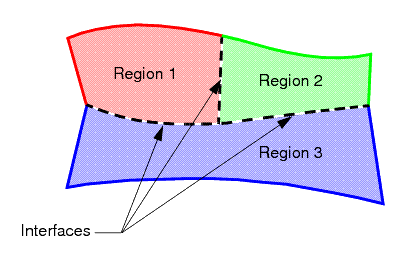What Are Interfaces?
Interfaces provide a connection between boundaries during the simulation meshing setup and/or analysis process.
They are always composed of boundary pairs, either in the same region or in different regions. There can be many (or zero) interfaces in a simulation.
When using the surface remesher, tetrahedral, polyhedral or prism layer meshers, interfaces may be defined to ensure that a conformal mesh is obtained between regions or within the same region if a baffle plane is required.

Interfaces have a topology and a type associated with them. In general, the topology refers to the physical arrangement of the interface boundaries. For example, in-place and repeating interfaces normally have coincident boundaries while a periodic interface has separated boundary pairs.
The interface type determines the modeling behavior of the interface. For example, depending on the topology selected, you can:
- Allow mass and energy to be exchanged between fluid and porous regions that have coincident boundary planes.
- Simulate baffles/porous baffles within a region.
- Provide a contact interface for heat transfer between fluid-solid and solid-solid regions.
- Specify a fully developed flow condition to simulate the pressure drop or mass-flow across a periodic (cyclic) across a region.